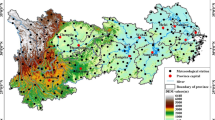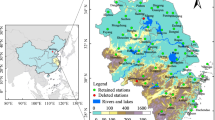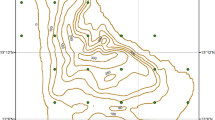Abstract
Winter westerly disturbances (WWD) are the primary climatic influence within High Mountain Asia during the boreal winter. Here we investigate variations and changes in WWD over the period 1979–2010 and relationships with heavy (85th percentile) precipitation in the Karakoram/western Himalaya (KH) and central Himalaya (CH) using multiple datasets. We show that heavy precipitation events occurring in the KH and CH are often spatiotemporally independent, suggesting differing behavior of WWD affecting each region. The wavelet power spectrum of 200 hPa geopotential height anomalies is used to characterize the frequency and magnitude of individual disturbances and to distinguish synoptic scale variability through time. Our analysis exhibits an enhancement in the strength and frequency of WWD in the KH and indicates an increase in local heavy precipitation events. In contrast, the CH is observed to experience weakening influence of these disturbances and consequently, a decrease in heavy precipitation. Furthermore, we investigate multi-annual variability of WWD and teleconnections with some known modes of climate variability affecting central Asia, including the Arctic Oscillation, Eurasian/Polar Pattern, the El Niño Southern Oscillation, and the Siberian High. Although there is clear evidence that these modes affect circulation and precipitation in High Mountain Asia, their competing influences on WWD are complex and non-linear. These results suggest that a thorough understanding of WWD and their spatiotemporal variations are crucial to improve our knowledge of the hydrologic cycle within High Mountain Asia as well as our ability to project the future status of Asia’s water resources.













Similar content being viewed by others
References
Archer DR, Fowler HJ (2004) Spatial and temporal variations in precipitation in the Upper Indus Basin, global teleconnections and hydrological implications. Hydrol Earth Syst Sci Discuss 8:47–61
Barlow M, Wheeler M, Lyon B, Cullen H (2005) Modulation of daily precipitation over southwest Asia by the Madden-Julian oscillation. Mon Weather Rev 133:3579–3594
Barros AP, Joshi M, Putkonen J, Burbank DW (2000) A study of the 1999 monsoon rainfall in a mountainous region in central Nepal using TRMM products and rain gauge observations. Geophys Res Lett 27:3683–3686
Barros AP, Chiao S, Lang TJ, Burbank D, Putkonen J (2006) From weather to climate—seasonal and interannual variability of storms and implications for erosion processes in the Himalaya. Geol Soc Am Spec Pap 398:17–38
Bhutiyani MR, Kale VS, Pawar NJ (2010) Climate change and the precipitation variations in the northwestern Himalaya: 1866–2006. Int J Climatol 30:535–548
Bolch T et al (2012) The state and fate of Himalayan glaciers. Science 336:310–314
Bookhagen B (2010) Appearance of extreme monsoonal rainfall events and their impact on erosion in the Himlaya. Geomat Nat Hazards Risk 1:37–50
Bookhagen B, Burbank DW (2010) Towards a complete Himalayan hydrological budget: the spatiotemporal distribution of snow melt and rainfall and their impact on river discharge. J Geophys Res-Earth 115:1–25
Bothe O, Fraedrich K, Zhu XH (2012) Tibetan Plateau summer precipitation: covariability with circulation indices. Theor Appl Climatol 108(293):300
Cohen J, Entekhabi D (1999) Eurasian snow cover variability and Northern Hemisphere climate predictability. Gephys Res Lett 26:345–348
Cohen J, Saito K, Entekhabi D (2001) The role of the Siberian high in northern hemisphere climate variability. Geophys Res Lett 28:299–302
Cohen J, Barlow MA, Kushner P, Saito K (2007) Stratospher-troposphere coupling and links with Eurasian land-surface variability. J Clim 20:5335–5343
Dimri AP (2006) Surface and upper air fields during extreme winter precipitation over the western Himalayas. Pure Appl Geophys 163:1679–1698
Dimri AP, Dash SK (2012) Wintertime climatic trends in the western Himalayas. Clim Change 111:775–800
Galewsky J (2009) Rain shadow development during the growth of mountain ranges: an atmospheric dynamics perspective. J Geophys Res-Earth 114:1–17
Gardelle J, Berthier E, Arnaud Y (2012) Slight mass gain of Karakoram glaciers in the early twenty-first century. Nat Geosci 5:322–325
Gong DY, Ho CH (2002) The Siberian High and climate change over middle to high latitude Asia. Theor Appl Climatol 72:1–9
Gong DY, Wang SW, Zhu JH (2001) East Asian winter monsoon and Arctic Oscillation. Geophys Res Lett 28:2073–2076
Greene CH, Monger BC (2012) Rip current news in oceanography an Arctic wild card in the weather. Oceanography 25:7–9
Huffman GJ et al (2007) The TRMM multisatellite precipitation analysis (TMPA): quasi-global, multiyear, combined-sensor precipitation estimates at fine scales. J Hydrometeorol 8:38–55
Kaab A, Berthier E, Nuth C, Gardelle J, Arnaud Y (2012) Contrasting patterns of early twenty-first-century glacier mass change in the Himalayas. Nature 488:495–498
Krishnamurti TN (1961) The subtropical jet stream of winter. J Meteorol 18:172–191
Lang TJ, Barros AP (2004) Winter storms in the central Himalayas. J Meteorol Soc Jpn 82:829–844
Medina S, Smull BF, Houze RA, Steiner M (2005) Cross-barrier flow during orographic precipitation events: results from MAP and IMPROVE. J Atmos Sci 62:3580–3598
Palazzi E, von Hardenberg J, Provenzale A (2013) Precipitation in the Hindu-Kush Karakoram Himalaya: observations and future scenarios. J Geophys Res-Atmos 118:85–100
Panagiotopoulos F, Shahgedanova M, Hannachi A, Stephenson DB (2005) Observed trends and teleconnections of the Siberian High: a recently declining center of action. J Clim 18:1411–1422
Rasmussen R et al (2012) How well are we measuring snow? The NOAA/FAA/NCAR winter precipitation test bed. B Am Meteorol Soc 93:811–829
Ridley J, Wiltshire A, Mathison C (2013) More frequent occurrence of westerly disturbances in Karakoram up to 2100. Sci Total Environ. doi:10.1016/j.scitotenv.2013.03.074
Saha S et al (2010) The NCEP climate forecast system reanalysis. B Am Meteorol Soc 91:1015–1057
Scherler D, Bookhagen B, Strecker MR (2011) Spatially variable response of Himalayan glaciers to climate change affected by debris cover. Nat Geosci 4:156–159
Singh P, Ramasastri KS, Kumar N (1995) Topographical influence on precipitation distribution in different ranges of western Himalayas. Nord Hydrol 26:259–284
Syed FS, Giorgi F, Pal JS, King MP (2006) Effect of remote forcings on the winter precipitation of central southwest Asia part 1: observations. Theor Appl Climatol 86:147–160
Syed FS, Giorgi F, Pal JS, Keay K (2010) Regional climate model simulation of winter climate over Central-Southwest Asia, with emphasis on NAO and ENSO effects. Int J Climatol 30:220–235
Takaya K, Nakamura H (2005) Mechanisms of intraseasonal amplification of the cold Siberian high. J Atmos Sci 62:4423–4440
Thompson DWJ, Wallace JM (1998) The Arctic Oscillation signature in the wintertime geopotential height and temperature fields. Geophys Res Lett 25:1297–1300
Torrance C, Compo GP (1998) A practical guide to wavelet analysis. B Am Meteorol Soc 79:61–78
Vallis GK, Gerber EP (2008) Local and hemispheric dynamics of the North Atlantic oscillation, annular patterns and the zonal index. Dyn Atmos Oceans 44:184–212
Wolter K, Timlin MS (2011) El Nino/Southern Oscillation behaviour since 1871 as diagnosed in an extended multivariate ENSO index (MEI.ext). Int J Climatol 31:1074–1087
Wu BY, Wang J (2002a) Possible impacts of winter Arctic Oscillation on Siberian high, the East Asian winter monsoon and sea-ice extent. Adv Atmos Sci 19:297–320
Wu BY, Wang J (2002b) Winter Arctic Oscillation, Siberian High and East Asian winter monsoon. Geophys Res Lett 29:1–4
Yadav RK, Rupa Kumar K, Rajeevan M (2009) Increasing influence of ENSO and decreasing influence of AO/NAO in the recent decades over northwest India winter precipitation. J Geophys Res-Atmos 114:1–12
Yadav RK, Yoo JH, Kucharski F, Abid MA (2010) Why is ENSO influencing northwest India winter precipitation in recent decades? J Clim 23:1979–1993
Yatagai A, Arakawa O, Kamiguchi K, Kawamoto H, Nodzu MI, Hamada A (2009) A 44-year daily gridded precipitation dataset for Asia based on a dense network of rain gauges. SOLA 5:137–140
Zhu XH, Bothe O, Fraedrich K (2011) Summer atmospheric bridging between Europe and East Asia: influences on drought and wetness on the Tibetan Plateau. Quat Int 236:151–157
Acknowledgments
This research was supported by the Climate and Large-scale Dynamics Program, from the National Science Foundation (NSF award-AGS 1116105) and by NASA Headquarters under the NASA Earth and Space Science Fellowship Program (Grant Number 13-EARTH13F-26). The CFSR data used in this research were developed by NOAA’s National Centers for Environmental Prediction (NCEP) and provided by NCAR. APHRODITE Water Resources project is supported by Environment Research & Technology Development Fund of the Ministry of the Environment, Japan. TRMM data were acquired by an international joint project sponsored by the Japan National Space Development Agency (NASDA) and the U.S. National Aeronautics and Space Administration (NASA) Office of Earth Science. The Authors would also like to thank Dr. George Kiladis and Dr. Rodrigo Bombardi for their help throughout this project.
Author information
Authors and Affiliations
Corresponding author
Rights and permissions
About this article
Cite this article
Cannon, F., Carvalho, L.M.V., Jones, C. et al. Multi-annual variations in winter westerly disturbance activity affecting the Himalaya. Clim Dyn 44, 441–455 (2015). https://doi.org/10.1007/s00382-014-2248-8
Received:
Accepted:
Published:
Issue Date:
DOI: https://doi.org/10.1007/s00382-014-2248-8




